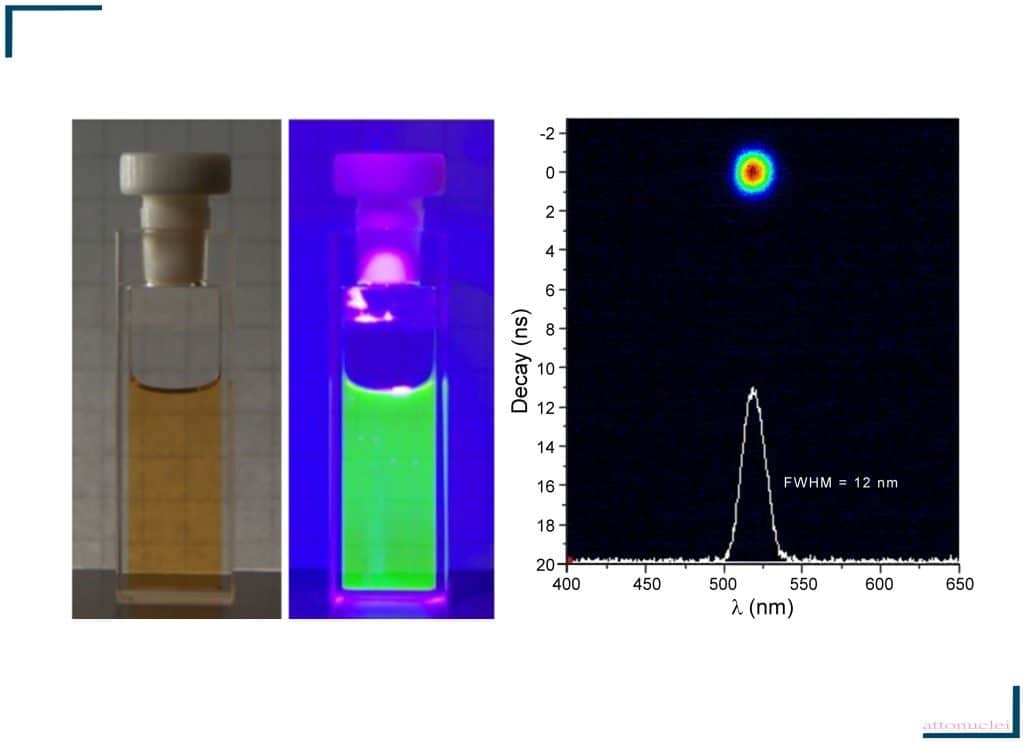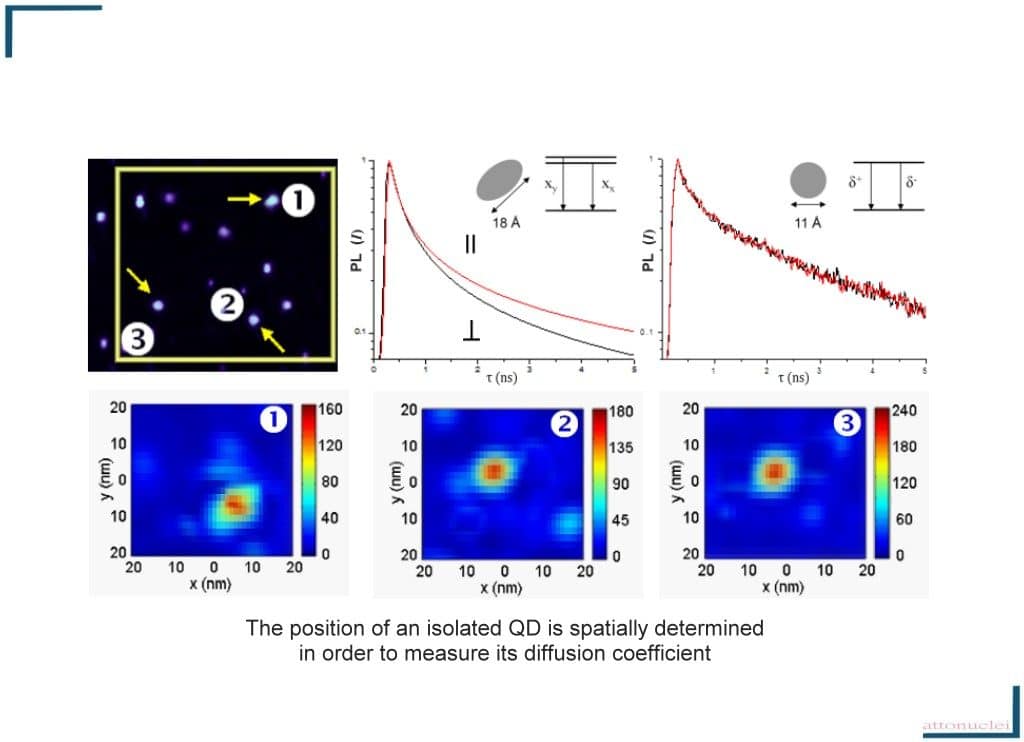In electronic industry, semiconductor quantum dots have attracted more and more interests in quantum dot single photon emitters for cryptography, solid-state lighting, and nanoteranostics fields due to the unique physical size-tunable light absorption and single line emission properties.
The large quantity demands of Quantum Dots for advanced applications require an industrial applicable production method. But, the current quantum dot synthesis methods by our concurrents can only fulfill the requirements of small-scale R&D applications.
Otherwise, ATTONUCLEI’s novel approaches of “mono-dispersed Quantum Dots” synthesis suitable for industrial scale production are thus essential for the high-end projects of ATTONUCLEI’s Quantum Dots based devices.

3D time resolved photoemission results:
PL color: Green
Emission max. (+/- 0.5nm) : 521
FWHM (nm): 12
Decay (ps)
: 150
In our research projects, nanoelectronics industry is one of the most interesting industry sector. Already in present time, nanotechnology has already been introduced to the integrated circuits are already in nano scale.
Remember that, the small number of carriers in the device is in contrast to standard semiconductor devices, where hundreds of thousands of electrons are streaming through a device to establish a particular state of the system. Quantum dots device and circuit concepts do not fight but utilize the discreteness of the electron charge. They offer a possible breakthrough technology for devices and circuits.
Also, Attonuclei is interested in fundamental electrical properties of engineered nanodevices operating in the quantum regime.
QD CRYPTOGRAPHY
One of our company’s interest and goal is investing in quantum dots based crypting devices, for instance creating quantum computing derives from the hope to outperform classical computer devices using new quantum algorithms. A natural candidate for the qubit is the electron spin because the only two possible spin orientations |↑⟩ and |↓⟩ correspond to the basis states of exactly one qubit. The basic difference between quantum computers and their classical counterparts is that quantum computers are built on qubits rather than bits.
Of course, Quantum Dots themselves are not the qubits. The reason to use them is because a quantum dot defines an « artificial atom », which is a zero dimensional that can trap one single electron which then stores the quantum information.
Electrons confined in Quantum Dots can be used as qubits based on their spin or charge degree of freedom. In the context of quantum information processing, cavity photons were first envisioned as a powerful way to manipulate such qubits.

Like bits, qubits are also measured using our classical binary system of 1s and 0s. But unlike a classical bit, qubits can be both a 1 and a 0 at the same time, what we measure determines what a qubits final output will be. We have two qubit properties that are assigned to one of those function superposition and second entanglement.
In superposition, a qubit can be in multiple states at the same time, having a value of not just 0 or 1, but both, and any amount of numbers in between. This has some serious implications for quantum dots based computing.
Another powerfull property of qubits is their capacity to be linked together, this function named entanglement, even more than 500 miles distances where there is zero possibility of a physical connection. When two qubits are linked together, they will both share a similar state, being 1 or 0. Also, each qubit that we add to the mix doubles the possible processing capabilities.
Just imagine, if we have entangled hundreds of qubits together, we could perform more parallel computations and simulations than there are known atoms in the universe.
Therefore, the potential of using the field of quantum information science can give rise to multiple high-security related applications. One of which, Quantum key distribution, quantum cryptanalysis and quantum sensing all promise to significantly affect strategic security in differing ways.
Up to now, many different physical realizations of qubits have been proposed theoretically and experimentally such as superconducting circuits, trapped ions and donors in Si etc. Among them design of “mono-dispersed Quantum Dots” based single photon emitters is most promising considering that their fabrication process is most compatible with standard solid state CMOS chip technology.
DISPLAY
Quantum Dots are appealing for displays because they can ultimately use one-fifth to one-tenth as much power as LCDs, which require backlights to illuminate their pixels.
Quantum Dots incorporate the best aspects of both organic and inorganic light emitters. These particles can be dispersed within or between organic (or in some cases inorganic) semiconductor layers and emit light of a specific color when charge carriers are injected. They are more robust than organic molecules, which tend to degrade and are particularly sensitive to humidity and oxidation, and can be tuned to emit light over a larger color gamut outdoing OLEDs in the purity of the colors that they emit.
But, a typical Quantum Dots based LED that glows green also gives aqua and yellowish photons (that) make it look whitish green, so it’ll be more washed out. Quantum dots nanocrystals give a larger emission spectrum, so the perception of color coming from them appears to be much richer.
Actually, ATTONUCLEI works on all inorganic printable “mono-dispersed Quantum Dots” based displays for low cost roll-to-roll print processing on inexpensive substrates.
This technology has the potential to deliver a significantly lower price point, and can also provide higher definition, increased viewing angles, reduced response time for an enhanced picture, all in a very thin filexible format.
FINALLY …
Technological evolution of new generation quantum dots have attracted our company attention as a next-generation of photovoltaics such as two-dimensional graphene and quasi zero-dimensional carbon quantum dots offers a large surface area, with high electrical conductivity, thinness and strength. This makes it an eligible candidate for the development of fast and efficient quantum dots based solar-cells.
Indeed, due to its high transparency can be used as the alternative to Si for manufacturing flexible tiny solar cells, also known as photovoltaic cells, are devices which convert sunlight energy into electrical energy without producing any environmental pollution during this process.
There are two important issues in designing a solar cell be able to produce smart molecules which use the solar spectrum, and make these molecules compatible with the other parts of the solar cell device for efficient energy conversion.